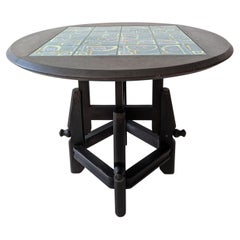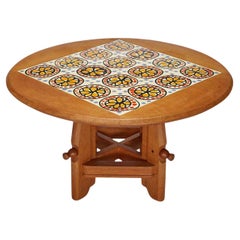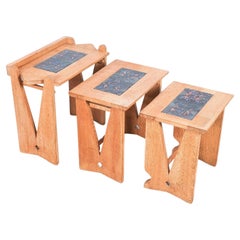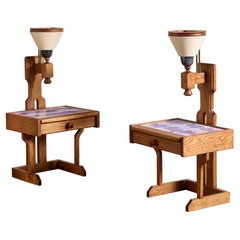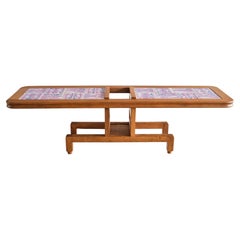Guillerme et Chambron Tables
Robert Guillerme and Jacques Chambron, the French creative duo behind Votre Maison, met under unusual circumstances: They discussed design while imprisoned in a forced labor camp. The pair’s combined talents later resulted in modern, sculptural furniture — today, vintage Guillerme et Chambron desks, dining tables, chairs and other pieces still look conceptually playful and vibrant but could fit harmoniously into any home.
Guillerme had graduated from the École Boulle in 1934 with a degree in design and architecture, and Chambron had studied at the School of Applied Arts in Reims. They were captured by the Germans in East Prussia during the Second World War and struck up a friendship over their mutual love for all things design.
After the war ended, Guillerme moved to Lille in northern France; Chambron left his job as a painter and decorator in Paris and joined him in 1948. In 1949, the pair met Émile Dariosecq, a skilled cabinetmaker who enthusiastically agreed to manufacture the duo’s designs, leading to the start of Votre Maison.
Guillerme and Chambron were as prolific as they were detailed, producing more than 2,000 pieces in the second half of the 20th century out of a former gun factory. Their furniture, which was mostly made with different tones of waxed oak, adhered to the trends of design that emerged after the war: mid-century modernism.
European furniture in the postwar period largely prioritized function as much as it did form and lacked any unnecessary ornamentation. Guillerme and Chambron wanted people to actually use their furniture, not just look at it. That design philosophy was a pillar of their company, its name translating to “your house” in French. Their signature touches included ornate tiles, hidden drawers and vibrant textiles on pieces such as desks, tables, shelving, lighting, benches and other seating. One of Votre Maison’s most famous and popular pieces was the Grand Repos armchair, a stately, high-backed wide piece with a skeletal oak frame, six spindles and plush cushions.
While Guillerme and Chambron were a team, they handled different aspects of the business: Guillerme designed much of the furniture and Chambron concentrated on decor. Votre Maison was a full-service design business. In 1983, the dynamic duo passed on their company to Chambron’s son, Hervé, a designer and graduate of École Boulle.
Find a collection of vintage Guillerme et Chambron furniture on 1stDibs.
Mid-20th Century French Mid-Century Modern Guillerme et Chambron Tables
Ceramic, Oak
1960s French Mid-Century Modern Vintage Guillerme et Chambron Tables
Ceramic, Oak
1960s French Mid-Century Modern Vintage Guillerme et Chambron Tables
Oak, Ceramic
1940s French Vintage Guillerme et Chambron Tables
Ceramic, Oak
1960s French Mid-Century Modern Vintage Guillerme et Chambron Tables
Ceramic, Oak
1960s French Mid-Century Modern Vintage Guillerme et Chambron Tables
Fabric, Oak
1960s French Mid-Century Modern Vintage Guillerme et Chambron Tables
Oak, Faux Leather
1950s French Mid-Century Modern Vintage Guillerme et Chambron Tables
Oak
1950s French Vintage Guillerme et Chambron Tables
Ceramic, Wood
1960s French Mid-Century Modern Vintage Guillerme et Chambron Tables
Leather, Oak
1960s French Mid-Century Modern Vintage Guillerme et Chambron Tables
Ceramic, Oak
1960s French Mid-Century Modern Vintage Guillerme et Chambron Tables
Oak
1960s French Mid-Century Modern Vintage Guillerme et Chambron Tables
Oak
1960s French Mid-Century Modern Vintage Guillerme et Chambron Tables
Ceramic, Fabric, Mirror, Oak
1960s French Mid-Century Modern Vintage Guillerme et Chambron Tables
Oak
1950s French Mid-Century Modern Vintage Guillerme et Chambron Tables
Ceramic, Oak
1960s French Mid-Century Modern Vintage Guillerme et Chambron Tables
Oak
1960s French Mid-Century Modern Vintage Guillerme et Chambron Tables
Stone
Mid-20th Century French Mid-Century Modern Guillerme et Chambron Tables
Oak
1970s French Mid-Century Modern Vintage Guillerme et Chambron Tables
Ceramic, Oak
1970s French Mid-Century Modern Vintage Guillerme et Chambron Tables
Belgian Black Marble, Brass
Mid-20th Century French Mid-Century Modern Guillerme et Chambron Tables
Oak
1970s French Mid-Century Modern Vintage Guillerme et Chambron Tables
Oak
Mid-20th Century French Mid-Century Modern Guillerme et Chambron Tables
Oak
Mid-20th Century French Mid-Century Modern Guillerme et Chambron Tables
Oak
1960s French Mid-Century Modern Vintage Guillerme et Chambron Tables
Ceramic, Wood, Oak
1970s French Modern Vintage Guillerme et Chambron Tables
Ceramic, Oak
1960s French Mid-Century Modern Vintage Guillerme et Chambron Tables
Oak
1970s French Modern Vintage Guillerme et Chambron Tables
Ceramic, Oak
1950s French Mid-Century Modern Vintage Guillerme et Chambron Tables
Ceramic, Oak
1960s French Mid-Century Modern Vintage Guillerme et Chambron Tables
Ceramic, Oak
1960s French Mid-Century Modern Vintage Guillerme et Chambron Tables
Ceramic, Oak
1970s French Modern Vintage Guillerme et Chambron Tables
Oak
1950s French Mid-Century Modern Vintage Guillerme et Chambron Tables
Marble, Iron
1970s French Mid-Century Modern Vintage Guillerme et Chambron Tables
Oak
1970s French Mid-Century Modern Vintage Guillerme et Chambron Tables
Ceramic, Oak
Mid-20th Century French Guillerme et Chambron Tables
Oak
Mid-20th Century French Mid-Century Modern Guillerme et Chambron Tables
Ceramic, Oak
1960s French Mid-Century Modern Vintage Guillerme et Chambron Tables
Ceramic, Oak
1960s French Mid-Century Modern Vintage Guillerme et Chambron Tables
Ceramic, Oak
Mid-20th Century French Mid-Century Modern Guillerme et Chambron Tables
Marble
1960s French Mid-Century Modern Vintage Guillerme et Chambron Tables
Ceramic, Glass, Oak
1960s French Mid-Century Modern Vintage Guillerme et Chambron Tables
Ceramic, Oak
Mid-20th Century French Mid-Century Modern Guillerme et Chambron Tables
Oak
1970s French Mid-Century Modern Vintage Guillerme et Chambron Tables
Belgian Black Marble, Brass
1950s French Mid-Century Modern Vintage Guillerme et Chambron Tables
Oak
Mid-20th Century European Mid-Century Modern Guillerme et Chambron Tables
Oak
1970s French Mid-Century Modern Vintage Guillerme et Chambron Tables
Ceramic, Oak
Late 20th Century French Modern Guillerme et Chambron Tables
Oak
1960s French Mid-Century Modern Vintage Guillerme et Chambron Tables
Oak
1970s French Mid-Century Modern Vintage Guillerme et Chambron Tables
Lava
Mid-20th Century European Mid-Century Modern Guillerme et Chambron Tables
Oak
1970s French Vintage Guillerme et Chambron Tables
Faux Leather, Oak
Mid-20th Century French Mid-Century Modern Guillerme et Chambron Tables
Oak
1960s French Mid-Century Modern Vintage Guillerme et Chambron Tables
Ceramic, Oak
1960s French Mid-Century Modern Vintage Guillerme et Chambron Tables
Ceramic, Oak
1960s French Mid-Century Modern Vintage Guillerme et Chambron Tables
Oak
20th Century French Modern Guillerme et Chambron Tables
Oak
1960s French Mid-Century Modern Vintage Guillerme et Chambron Tables
Oak
1970s French Mid-Century Modern Vintage Guillerme et Chambron Tables
Ceramic, Oak
